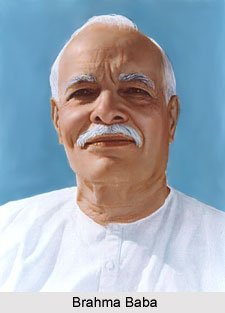 At an age when people think of retiring, Brahma Baba understood that the true mission of his life has just begun. His spiritual longing, those ceaseless visions crafted him as the founder of the movement of the Prajapita Brahma Kumaris Ishwariya Vishwa Vidyalaya. He has almost everything in him.
At an age when people think of retiring, Brahma Baba understood that the true mission of his life has just begun. His spiritual longing, those ceaseless visions crafted him as the founder of the movement of the Prajapita Brahma Kumaris Ishwariya Vishwa Vidyalaya. He has almost everything in him.
His soft white hair and a handsome visage and indeed his wisdom and soothing voice made Brahma Baba the spiritual leader. On a devout height, his existence was soothing and tender, and his eyes exhaled wisdom and understanding, love, strength and compassion.
Born in the year 1876 into a humble home as Lekhraj Kripilani, Brahma Baba was the son of a schoolteacher. Strict Hindu tradition was induced in him from his early days. However, Brahma Baba didn`t follow his father footsteps and instead of becoming a schoolteacher he entered into the jewellery business and established himself as a diamond trader. Known for his philanthropy and also known as a businessman Brahma Baba maintained a highly respectable position within the local community.
In the year 1836, Baba begun his journey, the journey in understanding the truths of life.
The journey was not at all easy. However one day while meditating he felt a warm flow of energy and witnessed a series of powerful vision. He kept on witnessing these powerful visions for about seven months and then the inevitable thing finally happened. His innate vision, his insight knowledge bestowed him with unexampled insights into the innate qualities of human souls whilst revealing the mystifying, deep and cryptical entity of God. Thus Brahma Baba identified the course of "world transformation". The intensity of this sheer understanding was so vivid, it was so very much pulsating that Brahma Baba was somewhat compelled to finish off his worldly business and finally devote himself to this supreme understanding and application of this revealed knowledge. The visions ceased yet the Source, the feeling, the understanding remained Although the visions with him for the next 3 decades which then steered his transformation and indeed of those close to him.
Brahma Baba`s Legacy
In 1936, at the age of 60, Dada Lekhraj started experiencing numerous trance-like visions. In some he saw Vishnu in his various forms of Narayana while in another he saw appalling panoramas of demolition and ruin. He heard a strange voice inside telling him to lay a foundation of a new world based on peace and a spirit of brotherhood.
Long seventy years have passed since Brahma Baba received those spiritual visions and through those transcendental vision a million has been benefited. From his teachings the mankind has found empowerment in the present whilst hoping for the future. Brahma Baba`s teaching thus stood the test of time.
At the age of 93, in the year 1969, Brahma Baba passed away. The tower of peace located at the Madhuban Campus is thus a tribute to this great persona; an honor to Brahma Baba who was once an ordinary being but attained that magnitude by realizing the sheer truths of life.
More on Brahma Kumaris
History of Brahma Kumaris
Spiritual Leaders of Brahma Kumaris
Brahma Kumaris Administration



















